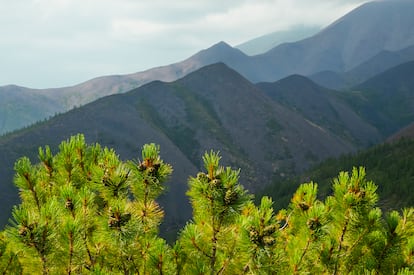The stlánik, the tree that lies down and sleeps during the winters

Strictly opinion pieces that reflect the author's unique style. These opinion pieces must be based on verified data and be respectful of individuals, even if their actions are criticized. All opinion columns by individuals outside the EL PAÍS editorial team will include, after the last line, a byline—no matter how well-known the author may be—indicating their position, title, political affiliation (if applicable), or main occupation, or any that is or was related to the topic addressed.

A peculiar tree known as the stlanik grows in the Siberian tundra . It is a cedar native to the mountains, a tree with which the prisoners condemned in Kolyma maintained a special relationship. This is how writer Varlam Shalamov, a Gulag survivor, recounts his Kolyma Tales (Minúscula), a starkly written epic poem translated into Spanish by Ricardo San Vicente.
According to Shalamov, the stlanik tree is endowed with an "uncommon" sensitivity. It is capable of announcing the arrival of the first snow by lying down until its crown touches the ground, "spreading its bluish branches like paws," writes Shalamov, expressing the miracle that nature presents before his eyes. It is the gaze of a convict, of a condemned man, but one who has not lost the thread of tenderness that unites him with the rest of the world. Despite the isolation, Shalamov details and notes the signs, the clues that nature emits with the passing of days in "the land of white death," as those inhospitable places are known where any sprouting of greenery is celebrated with the eyes.
Shalamov does it like a naturalist. In his field notebook, he describes the different shades the snow takes on as the day passes: the veil of fog that envelops the early mornings and the cold walk to work in the mine. He never loses his curiosity about the white mountains, where lumps of snow can be seen. Beneath them, the stlanik bushes hibernate, "like a bear, they sink into a winter sleep."
In this way, the stlanik becomes a barometer; just as it announces the first snowfall, it announces the budding of spring. Because far from the almanacs, spring, in those lands of death, came whenever it wanted. “Nature is somewhat more subtle than man in its sensations,” Shalamov explains, noting the awakening of the stlanik with the arrival of the first buds, when the tree rises from the ground, shaking off the snow under which it has remained buried during the winter. And Shalamov tells all this with masterful prose, a muscular phrasing without anabolics or fireworks, without concessions, as befits a life experience where the scythe of death lurks at every turn.
But stlanik also served as a source of vitamin C, or so Shalamov thought. In the spring and summer, he would pluck its dried needles, filling sacks that he would hand to the foreman. These sacks would then be taken to the kitchen, where they would prepare a yellowish concoction that had to be drunk before every meal. This was the only known remedy for scurvy, a disease caused by a lack of vitamin C.
Later, it was discovered that this was a lie, that stlanik needles were useless for scurvy or anything similar. And that drinking that concoction—which tasted like hell—was just another punishment in that land of death.
In short: the stlanik vitamin was a hoax, like the one you might practice when you lit a bonfire nearby while the tree was hibernating under the snow. Believing that spring had begun, the stlanik rose to celebrate. Because, like many human beings, the stlanik is also a naive and trusting tree.
The Stone Axe is a section where Montero Glez , with a desire for prose, exercises his particular siege on scientific reality to demonstrate that science and art are complementary forms of knowledge.
EL PAÍS

%3Aformat(jpg)%3Aquality(99)%3Awatermark(f.elconfidencial.com%2Ffile%2Fbae%2Feea%2Ffde%2Fbaeeeafde1b3229287b0c008f7602058.png%2C0%2C275%2C1)%2Ff.elconfidencial.com%2Foriginal%2F928%2F9e2%2Fea9%2F9289e2ea9a0474d811bad9fd917319cd.jpg&w=1280&q=100)
%3Aformat(jpg)%3Aquality(99)%3Awatermark(f.elconfidencial.com%2Ffile%2Fa73%2Ff85%2Fd17%2Fa73f85d17f0b2300eddff0d114d4ab10.png%2C0%2C275%2C1)%2Ff.elconfidencial.com%2Foriginal%2F99a%2F388%2F082%2F99a388082660da00c76f172c97498a4d.jpg&w=1280&q=100)
%3Aformat(jpg)%3Aquality(99)%3Awatermark(f.elconfidencial.com%2Ffile%2Fa73%2Ff85%2Fd17%2Fa73f85d17f0b2300eddff0d114d4ab10.png%2C0%2C275%2C1)%2Ff.elconfidencial.com%2Foriginal%2Fc37%2Fcb3%2F149%2Fc37cb3149dd47ba47faa45e3be4c50ad.jpg&w=1280&q=100)

